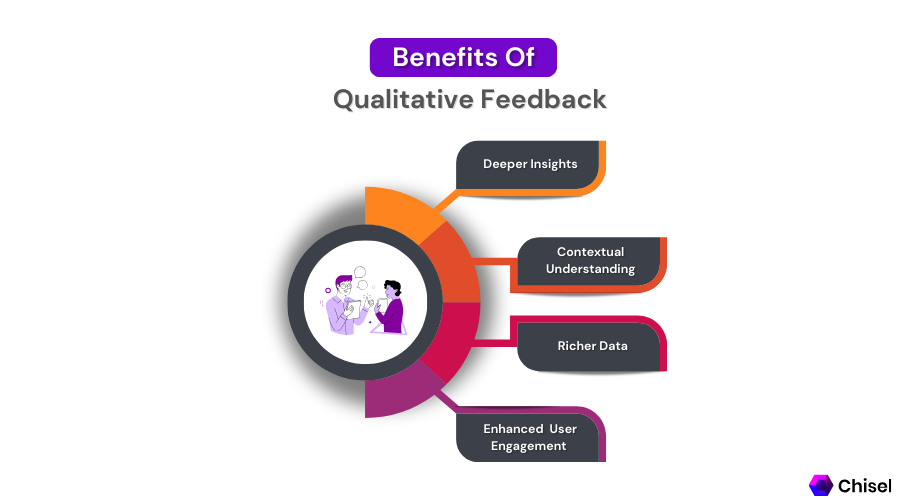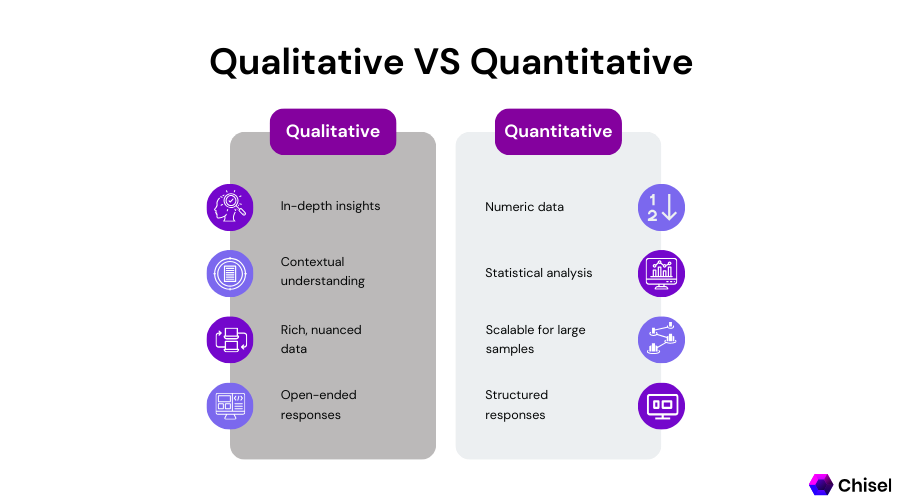Qualitative Feedback: How To Gather and Analyze It?

Qualitative feedback provides valuable insights into customers’ thoughts, feelings, and needs. It helps organisations make better decisions, improve products and services, and build better relationships with customers and employees.
Qualitative feedback is worth its weight in gold when it comes to an understanding of what your customers think. Unlike quantitative feedback, which can be helpful in its own right, qualitative feedback provides insights beyond the numbers to give you a deep understanding of your customer’s needs, motivations, and pain points.
Despite its importance, qualitative feedback is often misunderstood and underutilized.
Organizations must balance the need to generate reliable and valid quantitative data with the importance of hearing the voices of the people they serve. Qualitative feedback is essential to understanding how to best support clients, staff, and other key stakeholders. Qualitative feedback can provide rich insights that lead to programmatic improvements when done well.
However, gathering and analyzing qualitative feedback can be a daunting task. But we have carefully churned out a few of the dos and don’ts for you to save that precious time. Reading this blog through will provide an overview of qualitative feedback, how it can be gathered, and how you can analyze it.
We will walk you through the qualitative feedback process, from picking to exploring it. By the end of this article, you will have a clear understanding of how to use qualitative feedback to improve your business.
What Is Qualitative Feedback?
First and foremost, let’s clarify our basics because having a visceral idea isn’t enough.
Qualitative feedback is defined as information that companies cannot measure numerically. Companies can use it to understand people’s opinions, attitudes, and experiences. It can be collected through interviews, focus groups, and open-ended survey questions.
Overall, You can use this type of feedback through surveys or interviews to gain insights into customer behavior or perceptions.
As you read on, we will discuss the importance of qualitative feedback in detail, but let’s give you a succinct idea about it.
We can write an encomium about its merits. However, it is essential to note that this type of feedback is not always easy to quantify. Therefore, companies often use it alongside quantitative feedback to get a complete picture.
What Is an Example of Qualitative Feedback?
Still confused,
Don’t worry. We will explain through examples in this section.
In general, qualitative feedback is the feedback that is less specific and measurable than quantitative feedback. Qualitative feedback often focuses on overall impressions, ideas, and emotions.
- The most straightforward example will be if a customer says they love your product; that is an example of qualitative feedback.
- Another example is when a customer leaves a review of a product and describes their experience with it in detail. This type of feedback can help you understand how well a product performs and what improvements you can make.
Now let’s elucidate further through a study,
In a recent study, subjects were asked to rate their satisfaction with a new product on a scale of 1 to 10. The results showed that the average satisfaction level was 8.5.
However, when teams gathered qualitative feedback, it became apparent that many of the subjects who rated the product highly were doing so because they felt it was a good value for the price.
In other words, they were satisfied with the product, but the price point largely drove their satisfaction.
This example highlights the importance of qualitative feedback in addition to quantitative data. While quantitative data can give you a broad overview of customer satisfaction, qualitative feedback can help you understand the driving factors behind that satisfaction (or dissatisfaction).
This information can be invaluable in making decisions about future products or pricing.
How to Collect Qualitative Feedback?
Now you are well versed in the importance of qualitative feedback for companies. It’s time to shed some light on how to collect the same.
There are two main types of feedback: quantitative and qualitative. Quantitative feedback is easier to collect and can be measured using numbers, but qualitative feedback is often more valuable as it provides insights into customer motivations and emotions.
Qualitative feedback is indispensable for any business looking to improve its products or services. Without feedback, it can be challenging to know what changes need to be made to enhance the customer experience.
There are several ways to collect qualitative feedback; the best method will vary depending on your specific needs.
Some standard methods include interviews, focus groups, and surveys. Each method has advantages and disadvantages, so choosing the right approach for your specific needs is essential.
Our top 3 ways to collect qualitative surveys are the following.
1. Customer surveys: One popular method is to use surveys. Surveys can be sent to customers after they purchase or use your service. Companies can also send it to a random sample of potential customers.
You can use surveys to ask customers about their experiences with your products or services. Surveys can be administered online, in person, or over the phone.
Include a clickable link to the loyalty page in your digital business card and share it with customers both in-person and online. Check online resources to find the best digital card solutions.
Surveys are a great way to collect large amounts of feedback quickly and efficiently.
Want great software that helps you create, send, and manage surveys? Then look no further than a seamless product management system like Chisel.
2. Focus groups: Another popular method is to use focus groups. Focus groups are groups of people who you bring together to discuss a specific topic.
Focus groups allow you to get feedback from a group of people at once. This can be helpful if you want to gather feedback from a large number of people or if you want to hear different points of view. However, focus groups can be challenging to manage and may not provide as detailed feedback as individual interviews.
3. Interviews: This is the third and most effective way of collecting qualitative feedback since they provide in-depth feedback from individual users. You can ask follow-up questions and get detailed responses. However, interviews can be time-consuming and expensive to conduct.
We have already briefly touched upon the benefits of qualitative feedback. Now let’s get down to the brass tracks and discuss them in detail.
Why You Cannot Ignore Qualitative Feedback?
Companies often treat qualitative feedback as less critical than quantitative feedback. However, this is not the case – qualitative feedback is just as essential, if not more important, than quantitative feedback.
Here’s why you cannot ignore qualitative feedback:
Qualitative feedback is a type of feedback that sheds light on the user’s experience and provides insights that cannot be gleaned from quantitative data alone.
1. It helps you understand the why behind the numbers. It provides valuable insights into customer experiences and emotions. This is essential in any user-centered design process, as the design should be based on the user’s needs and not the designer’s preferences. Creating a genuinely user-centric design is demanding without understanding the user’s point of view.
2. One of the reasons why qualitative feedback is so important is because it helps to understand the user’s point of view. It can help you identify unmet needs and areas for improvement.
3. It can help you better understand your customers and what they want. Another important reason for qualitative feedback is that it can help uncover user needs that are not immediately apparent. It’s more emotional. Qualitative feedback can give you a better sense of how customers feel about your product or service. This can be invaluable when making decisions about future products or services.
Ignoring qualitative feedback would be a mistake – consider it when making decisions about your business.

So next time you’re tempted to dismiss qualitative feedback, think again – it might just be the most important piece of information you have.
How to Analyze Qualitative Feedback?
Now you know the importance and the method to collect qualitative feedback.
What should be the next step
However, there are several thwarts, as it can be difficult to identify trends and patterns.
First, consider the following question before diving into the analysis.
- What is the context of the feedback.
- What was the customer’s experience? How did they feel about it?
- Was there anything about the experience that stood out to them?
- What are the patterns in the feedback?
- Are there any common themes?
- Finally, don’t forget to consider the tone of the feedback. Are people generally happy or unhappy? What are their overall opinions of your business?
After addressing these questions, it’s time to analyze your qualitative feedback. You can use the following ways.
- One way is to open-code the feedback, which involves coding the feedback so you can identify themes and patterns. It also consists in reading through the feedback and assigning it to different categories. For example, you could create categories for various topics, such as product quality, customer service, or shipping. Once the feedback is coded, you can analyze it to see which topics are mentioned the most.
- You can also use sentiment analysis to analyze qualitative feedback, which determines the emotions expressed in the feedback.
- Another method you can use to analyze qualitative feedback is to look for themes. You can look for common themes in the comments. This can help you to identify areas that need improvement. This involves reading through the feedback and looking for common themes or patterns.
Qualitative vs. Quantitative Feedback – Which Is More Helpful?
The age-old debate of qualitative vs. quantitative feedback has been around for years. And while there is no clear answer as to which is more helpful, it is essential to understand the difference between the two.
Now, look at the differences between qualitative and quantitative feedback.
- Definition: Qualitative feedback is more descriptive and gives businesses a better understanding of customer needs and wants. On the other hand, quantitative feedback is more focused on numbers and data.
- Helpful in: Qualitative feedback is probably more helpful if a company tries to understand customer needs. However, quantitative feedback might be more useful if a business is trying to track customer satisfaction levels. Ultimately, it’s up to the company to decide which type of feedback is more helpful in a given situation.
- Focus: Qualitative feedback is more focused on the person’s feelings and opinions, while quantitative feedback focuses more on numbers and data. So which type of feedback is more helpful?
- Character: Qualitative feedback can be more open-ended and allow for a more in-depth discussion, but it can also be more subjective. Quantitative feedback can be more specific and to the point, but it can also be less personalized.

Collecting both kinds of data is the best way to get helpful feedback.
Conclusion
As we mentioned in this blog, qualitative and quantitative feedback is crucial for businesses to grow. Companies that emphasize their customers are likely to be more successful.
You may be used to dealing primarily with quantitative data as a business owner or leader. After all, numbers don’t lie. While this is true to some extent, relying too heavily on numbers can cause you to ignore important qualitative feedback that can give you valuable insights into your business.
Be sure to consider qualitative and quantitative data when making decisions about your business if you have read this blog to the fullest. You have already gained all those precious insights to help you take your feedback collection game to the next level.
